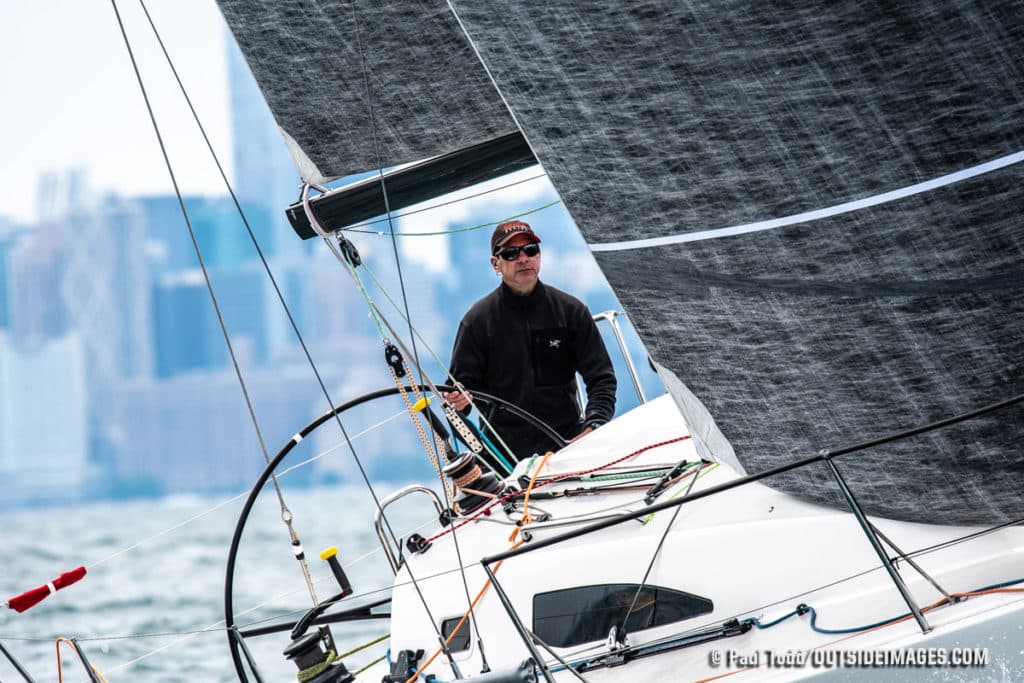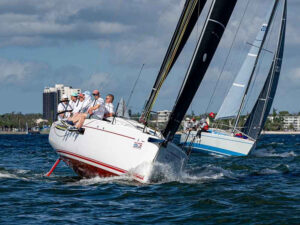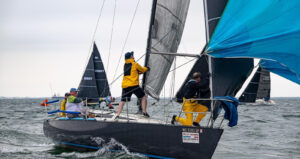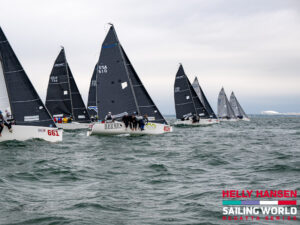The name of Jeffrey Davis’ J/111, Shamrock, has nothing to do with luck, although he recognizes a stroke of good fortune could come into play at the class’s world championship in Chicago in August. Davis’ says the name is simply a nod to his Irish wife, who blessed his decision to sell the family Beneteau 36.7 four years ago and upgrade to a more challenging raceboat.
“We raced the Beneteau throughout the Midwest and went as far as we could, winning a lot of regattas on the Great Lakes and finishing second at the North Americans,” says Davis, of Cleveland, Ohio. “We were looking for a new challenge, something more interesting and competitive. It turned out to be way more fun to drive.”
His search for a new ride led to George Gamble’s world championship-winning J/111 My Sharona. Buying a proven steed, however, was no guarantee of overnight rookie success.
It was well taken care of, Davis says, but keeping the boat competitive is an ongoing process. “We’re always innovating on the boat,” he says. “If we don’t, someone else will.”
“Along the way, we tried different crew because we need different characteristics on this boat”
Immediately after buying the boat, Davis and his core crew set about getting used to the boat, to sailing with an asymmetric spinnaker and fast downwind angles. “It has a much bigger range than the 36.7 so it took a lot to get used to in the first year,” Davis says, “and it was clear we needed a lot of work.”
They did go right to work, trailering the boat to Key West Race Week in their second year, and after five days of racing, gained a better feel for the boat and what they needed in terms of crew, sails, and boat preparation.

“My tactician and coach for last 10 years, Wally Cross, had experience in the J/111 fleet,” Davis says, “our philosophy was to have everything simple and repeatable. It takes time to understand how the boat performs in different conditions how you want it to.”
The boat had an epoxy bottom which wasn’t ideal for wet sailing at Cleveland YC, so they attacked the bottom, switching to Interlux VC Offshore ablative paint, laboriously sanding it to a mirror finish. Upgrades to the boat’s running rigging followed. Then came a weight-loss program, the sail inventory, and addressing simple improvement to prevent future mistakes.
The final piece was the crew. “Along the way, we tried different crew because we need different characteristics on this boat,” Davis says. “The crew turned out to be the last factor we could really change on the boat. It’s much a more athletic boat and a more competitive fleet. They’re all very serious racers and fitness, stamina and agility are important. To sail it well we have to sail it like dinghy, with roll tacks and jibes and other things to maintain momentum and speed.”
All improvements to the boat were focused on ensuring maneuvers were as consistent as they could be, says Davis. “The old set up was good, but we had to take it a step further so we could better shift gears. The best sailors take advantage of changes on the racecourse, but to do that you have to make last minute decisions strategically. To support that, you need the crew—and the boat—to work perfectly all the time.”
On an impromptu tour of his improvements to Shamrock, Davis starts at the bow: carbon tubes cover the lifelines and station tops to prevent spinnaker snags. The forestay was a major change as well. They lobbied hard to be able to change from the old roller furler to a Tuff Luff foil. In the forward cabin, they eliminated snag points, covering the head and sink with mesh, and added a string take-down line to all spinnakers. “It gets it into the boat quickly, which means we can carry it longer,” Davis says “My foredeck guy says it’s a massive improvement for him, and I’ll about convenience and comfort for the crew.”
All the pit clutches were removed and replaced with constrictors, which Davis says saves wear and tear on the lines, are more reliable than traditional clutches, and are easier to maintain. “It’s also about weight because we sail on Lake Erie for club racing and it’s a light-air lake,” Davis says, adding that weight is an easy speed-sapping source to tackle. It just takes diligence. “Most crews have a bad habit of bringing stuff to the boat and never taking it off, so the boat captain sweeps through the boat every night and makes sure we have all the stuff off the boat that’s not class required or necessary.”
With the Worlds in August creeping ever closer, Davis is confident team Shamrock is making right steps to get the podium. “If you look at our results over the past three years, we’re in the top quarter and often on the podium,” he says. “Were fine-tuning the crew and the boat and our goal is to win, which takes skill—and luck.”
And that, perhaps, is where Mrs. Davis’ Irish influence may come into play some day, but for now, with a day’s racing in the can and three wins in four races, there’s no need for any luck yet.









